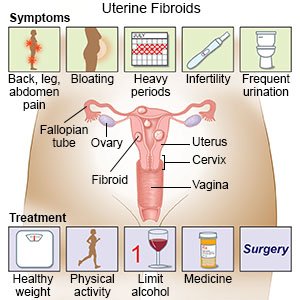Myomectomy
Medically reviewed by Drugs.com. Last updated on Apr 6, 2025.
A myomectomy is surgery to remove one or more myomas from your uterus. Myomas are also called fibroids or leiomyomas. A myomectomy can be done in several ways. Your surgeon will talk to you about the best way for you. This may depend on your age, health, how many fibroids you have, and where they are located.
 |
DISCHARGE INSTRUCTIONS:
Call your local emergency number (911 in the US) for any of the following:
- You feel lightheaded, short of breath, and have chest pain.
- You cough up blood.
Seek care immediately if:
- Your arm or leg feels warm, tender, and painful. It may look swollen and red.
- You cannot urinate, or you urinate very little.
- You have bleeding from your vagina that does not stop.
- You suddenly have severe abdominal pain.
- Your stitches come apart.
Call your surgeon or gynecologist if:
- You start to bleed more than usual during or between your monthly periods, after your fibroids are removed.
- You are constipated.
- You feel new pressure in your abdomen.
- You have a fever.
- You have nausea or are vomiting.
- You have new pain in your abdomen, or you have pain that is getting worse.
- Your wound is swollen, red, or has pus coming from it.
- You have questions or concerns about your condition or care.
Medicines:
You may need any of the following:
- Prescription pain medicine may be given. Ask your healthcare provider how to take this medicine safely. Some prescription pain medicines contain acetaminophen. Do not take other medicines that contain acetaminophen without talking to your healthcare provider. Too much acetaminophen may cause liver damage. Prescription pain medicine may cause constipation. Ask your healthcare provider how to prevent or treat constipation.
- Antibiotics help prevent or fight a bacterial infection.
- Take your medicine as directed. Contact your healthcare provider if you think your medicine is not helping or if you have side effects. Tell your provider if you are allergic to any medicine. Keep a list of the medicines, vitamins, and herbs you take. Include the amounts, and when and why you take them. Bring the list or the pill bottles to follow-up visits. Carry your medicine list with you in case of an emergency.
Wound care:
Care for your wound as directed. You may need to wash the wound with soap and water. Dry the area and put on new, clean bandages as directed. Change your bandages when they get wet or dirty.
Self-care:
Your healthcare provider will give you specific instructions based on the kind of myomectomy you had. The instructions will include when it is safe to have sex and return to other daily activities. It is important to follow all of your instructions. The following are general guidelines to help your body heal and to help prevent infection:
- Rest as needed. Rest and sleep will help your body heal.
- Follow your healthcare provider's instructions for activity. If you had the least invasive kind of procedure, you may be able to start your normal activities within 2 days. For a laparoscopic or open surgery, you may need to be careful for 4 to 6 weeks while you recover. This includes no strenuous exercise, such as lifting weights. Your provider will tell you when it is okay to start driving and to return to work.
- Do not use tampons, douche, swim, take a bath, or soak in a hot tub for 6 weeks. This will help prevent an infection.
- Ask about birth control. It may take a few months for your monthly period to return to normal. Ask your healthcare provider about your risk for pregnancy. You may need to use birth control to prevent pregnancy for a few months while your body heals. Your healthcare provider will tell you when it safe for you to try to become pregnant if you want to try.
Follow up with your surgeon or gynecologist as directed:
You may need to return for an ultrasound to check for new fibroids. Write down your questions so you remember to ask them during your visits.
© Copyright Merative 2025 Information is for End User's use only and may not be sold, redistributed or otherwise used for commercial purposes.
The above information is an educational aid only. It is not intended as medical advice for individual conditions or treatments. Talk to your doctor, nurse or pharmacist before following any medical regimen to see if it is safe and effective for you.
Further information
Always consult your healthcare provider to ensure the information displayed on this page applies to your personal circumstances.
